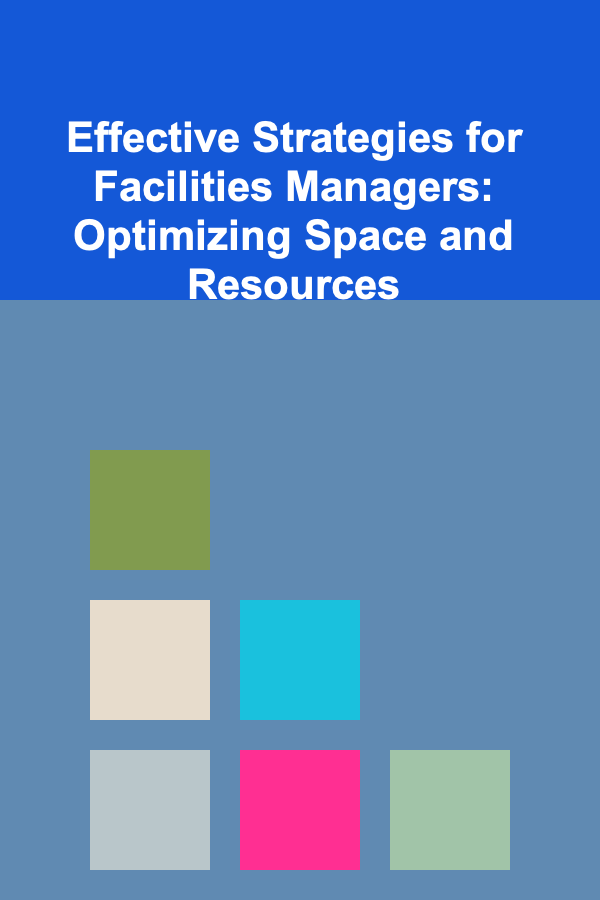
Effective Strategies for Facilities Managers: Optimizing Space and Resources
ebook include PDF & Audio bundle (Micro Guide)
$12.99$7.99
Limited Time Offer! Order within the next:

Facilities management is at the heart of operational efficiency in any organization. One of the key areas that facilities managers need to focus on is the optimization of space and resources. The way a facility is managed, from space utilization to resource allocation, can have a significant impact on cost-efficiency, employee satisfaction, and overall productivity. This article explores effective strategies for facilities managers to optimize space and resources, ensuring that operations are running smoothly and efficiently while reducing unnecessary costs.
Understanding the Importance of Space Optimization
Space optimization refers to the effective and efficient use of available space within a facility to maximize functionality, productivity, and cost-effectiveness. It involves ensuring that every square foot serves a specific purpose and is used to its full potential.
Key Benefits of Space Optimization:
- Increased Productivity: Well-organized spaces improve workflow and reduce distractions, allowing employees to focus better on their tasks.
- Cost Savings: Efficient space utilization reduces the need for additional office space, potentially lowering rent and utility costs.
- Flexibility: Optimized spaces can easily adapt to changing business needs, whether that involves accommodating more employees or repurposing areas for new functions.
- Improved Employee Well-being: A well-designed workspace can promote employee satisfaction, leading to better retention and a more motivated workforce.
Actionable Strategies for Space Optimization:
1.1 Conduct a Space Utilization Audit
Start by conducting a comprehensive audit of the existing space to assess how it is being used. This involves collecting data on occupancy rates, room usage, and identifying underutilized or overcrowded areas. A space utilization audit helps in understanding the exact patterns of how the space is being used and where improvements can be made.
- Tools to Consider: Use software tools that track occupancy and space usage in real-time, such as space management platforms or Building Information Modeling (BIM) systems.
- Data-Driven Insights: Collect feedback from employees about their work environment. This will provide insight into how well the space meets their needs and help identify areas for improvement.
1.2 Implement Flexible Workspaces
Flexible workspaces, such as open-plan offices, shared desks, and collaborative meeting rooms, can help optimize the use of space. This strategy has become especially popular with the rise of remote and hybrid work models.
- Hot Desking: Encourage hot desking, where employees do not have assigned desks but instead choose where they work each day based on availability. This allows for better utilization of desk space, reducing the need for individual offices.
- Breakout Rooms: Create designated areas for collaboration and brainstorming. These rooms can be used for meetings or casual discussions and can double as quiet spaces during downtime.
1.3 Redesign Layouts Based on Functionality
When redesigning a workspace, think in terms of functionality and adaptability. Ensure that the layout accommodates both individual tasks and group collaboration.
- Zoning: Designate specific zones within the office for different activities. For example, quiet zones for focused work, open spaces for collaboration, and lounges for informal meetings or breaks.
- Multi-purpose Spaces: Consider designing rooms that can be easily converted for different uses. A meeting room, for example, could also function as a training space or an event venue, depending on the needs of the organization.
1.4 Leverage Technology for Smart Space Management
Advancements in technology offer facilities managers tools to optimize space utilization dynamically. Smart building technologies can track occupancy and provide real-time data to help make informed decisions about space management.
- IoT-Enabled Sensors: Install Internet of Things (IoT) sensors in meeting rooms, offices, and other spaces to monitor occupancy and usage patterns. This allows you to adjust the space in real-time based on demand.
- Space Reservation Systems: Implement systems that allow employees to reserve workspaces, meeting rooms, or equipment, ensuring that the space is being used efficiently.
Resource Optimization: Maximizing Efficiency
Resource optimization involves the effective use of all resources within a facility, from utilities and supplies to human capital and technology. Efficient resource management leads to cost savings, reduced waste, and a more sustainable facility operation.
Key Benefits of Resource Optimization:
- Cost Reduction: By reducing unnecessary consumption of energy, water, and supplies, facilities can cut down on operational expenses.
- Sustainability: Optimizing resources contributes to a more sustainable environment, reducing the overall environmental footprint of the facility.
- Operational Efficiency: Proper resource allocation ensures that teams have what they need to complete their tasks without delays or excess inventory.
Actionable Strategies for Resource Optimization:
2.1 Implement Energy-Efficient Practices
Energy costs are one of the largest expenses for any facility. By implementing energy-efficient practices, facilities managers can significantly reduce energy consumption and cut costs.
- Energy Audits: Conduct regular energy audits to identify inefficiencies in lighting, heating, ventilation, and air conditioning (HVAC) systems. This helps pinpoint areas where energy savings can be made.
- Upgrade to Energy-Efficient Equipment: Replace outdated equipment with energy-efficient alternatives. Consider upgrading to LED lighting, smart thermostats, and energy-efficient HVAC systems that automatically adjust based on occupancy.
- Use Energy Management Systems (EMS): An EMS can help track and manage energy usage across the building, providing insights into how to further optimize consumption.
2.2 Manage Water Usage
Water is another resource that can be optimized in a facility. Facilities managers can implement strategies to reduce water usage, which leads to cost savings and a more sustainable building.
- Install Water-Efficient Fixtures: Replace old fixtures with low-flow faucets, toilets, and showerheads to reduce water consumption.
- Monitor Water Consumption: Use smart meters to track water usage and identify leaks or inefficiencies in the plumbing system.
- Rainwater Harvesting: For facilities with outdoor spaces, consider setting up rainwater harvesting systems to reduce reliance on municipal water sources for landscaping needs.
2.3 Optimize Inventory and Supplies Management
Inefficient management of supplies and inventory can lead to overstocking, wasted resources, and unnecessary costs. Facilities managers should adopt a streamlined approach to inventory management.
- Just-In-Time Inventory: Adopt a just-in-time (JIT) inventory system to ensure that supplies are ordered only when needed, minimizing storage costs and reducing waste.
- Automated Tracking: Use inventory management software to track supplies in real-time, automatically alerting you when stocks are running low and helping you maintain optimal inventory levels.
- Sustainable Products: Choose environmentally friendly cleaning supplies, paper products, and consumables. This not only optimizes resources but also contributes to the facility's sustainability goals.
2.4 Improve Waste Management and Recycling
Effective waste management ensures that resources are used efficiently and that waste is minimized. Recycling programs can be incorporated into a facility's daily operations to ensure that materials are being reused wherever possible.
- Implement Waste Segregation: Provide clearly marked bins for different types of waste (recyclables, compost, general waste) to encourage proper disposal and reduce contamination.
- Monitor Waste Generation: Track waste output to identify areas where excess waste is being generated. Work with vendors to find ways to reduce waste through better packaging or alternative materials.
- Compost Organic Waste: For facilities with large kitchens or cafeterias, consider setting up a composting program for food waste.
2.5 Optimize Human Resources
Efficient management of human resources is just as crucial as managing physical resources. Ensuring that employees are utilized effectively will improve overall productivity and reduce unnecessary labor costs.
- Flexible Scheduling: Implement flexible work schedules to ensure that employees are working during peak hours when their skills are needed the most.
- Training and Development: Regularly train your staff on best practices in space and resource management to ensure that they are well-equipped to optimize the facility's operations.
- Automate Routine Tasks: Use automation tools to handle repetitive tasks such as work order management, lighting control, or temperature regulation, freeing up staff to focus on more critical activities.
Creating a Culture of Continuous Improvement
To truly optimize space and resources, facilities managers must foster a culture of continuous improvement. By encouraging innovation and regularly assessing performance, facilities managers can ensure that their strategies remain effective and adaptable.
Strategies for Continuous Improvement:
3.1 Regular Feedback Loops
Encourage feedback from building occupants and staff about their experiences with space and resource utilization. Regular surveys or suggestion boxes can provide valuable insights that help improve processes.
3.2 Performance Metrics
Set clear, measurable goals for space and resource optimization, and track progress over time. Use key performance indicators (KPIs) such as energy consumption per square foot, space occupancy rates, and cost savings to evaluate the effectiveness of your strategies.
3.3 Stay Current with Trends and Technology
Facilities management is constantly evolving, and staying informed about the latest trends and technological advancements is essential. Attend industry conferences, read relevant publications, and network with other professionals to ensure your facility management strategies remain cutting-edge.
Conclusion
Optimizing space and resources is a complex but essential part of facilities management. By applying these effective strategies, facilities managers can reduce costs, improve efficiency, and create a more sustainable environment. From space audits and flexible workspaces to energy-efficient practices and waste reduction, the key to success lies in using resources wisely and continuously striving for improvement. By adopting these actionable strategies, facilities managers can ensure that their facilities are running at peak performance, benefiting both the organization and its occupants.

How to Designate a Craft Zone in Your Home
Read More
How to Make Money Online as an Instagram Growth Expert
Read More
How to Pack Efficiently for Your Upcoming Move
Read More
How to Understand the Fundamentals of Altcoins
Read More
How To Grow Heirloom Vegetables
Read More
How to Discover New Treatments for Autoimmune Diseases
Read MoreOther Products

How to Designate a Craft Zone in Your Home
Read More
How to Make Money Online as an Instagram Growth Expert
Read More
How to Pack Efficiently for Your Upcoming Move
Read More
How to Understand the Fundamentals of Altcoins
Read More
How To Grow Heirloom Vegetables
Read More